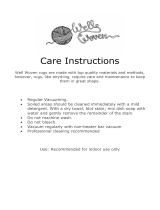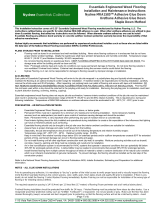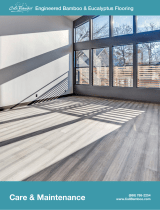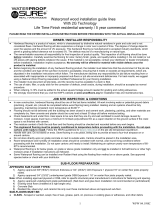
FLOOR CARE AND PREVENTIVE
MAINTENANCE
With today’s nishes, maintenance of your wood oor could not be easier. Normal maintenance consists of
regular sweeping or vacuuming to collect dirt and grit that can dull your nish, along with periodic use of an
approved no-wax hardwood oor cleaner. For Handscraped/Distressed oors, the uneven surface may trap dirt
and dust so we recommend vacuuming more often. Always vacuum thoroughly prior to the use of approved oor
cleaner. Be certain the wheels of the vacuum are clean and do not damage the nish. Scrubbing machinery, power
scrubbers and steam cleaners are not recommended to clean the oor.
PREVENTIVE MAINTENANCE
Aside from those mentioned above, other steps can also be taken to minimize wear and tear and keep your oor
looking new for years to come.
• DO NOT USE liquid or paste wax, oil soaps, or any other cleaners that contain silicon, lemon oil, tung oil,
acrylics or ammonia. Furthermore, avoid ‘home recipes’ found on the internet or other sources. These products
and techniques can cause your oors to become slippery, or cloud and dull the nish. Use of these and similar
products can harm the performance of your oor and may also affect its re-coat ability.
• DO NOT USE A VACUUM WITH A BEATER BAR HEAD
• Use throw rugs inside and outside of entryways to prevent dirt and grit from being tracked in and scratching
your nish. Rugs, mats or backings should not be abrasive to prevent scratching to the wood oor. Material
should be breathable to avoid trapping moisture underneath.
• Wood and water don’t mix! Never damp mop your oor. Clean up spills promptly with a soft cloth and
recommended cleaning products.
• Place felt-type protectors on the bottom of all furniture and xture legs to assist in preventing denting and
scratching.
• High heels and sports cleats will likely dent, gouge or scratch hardwood oors, which is not covered by our
warranty.
• Keep pet’s nails trimmed and clean of dirt and debris.
• Avoid sliding or rolling heavy furniture or appliances across the oor. Whenever possible, lift the item to be
moved. If it must be rolled, protect the oor with plywood or other hard sheeting to prevent dents.
• Use a humidier/dehumidier to maintain a consistent year round climate, keeping wood shrinkage and
movement to a minimum.
• The exposure of sun, UV rays and articial lighting accelerate the oxidation and aging of wood. This can cause
the wood and/or stain to change color and/or fade over time. If possible, we recommend that you rearrange
xtures, rugs and furniture periodically to ensure the ooring ages evenly. Our warranties do not cover damage
from the sun, UV rays or articial light. Note: American Cherry and Walnut species are especially susceptible to
the effect of light and may darken or lighten due to UV or articial light exposure. These species change color
more rapidly than other Domestic Species.
• Furniture casters should have wheels constructed with soft, non-marring/marking material such as soft rubber,
or covered with felt. Hard wheeled casters such as plastic, vinyl or hard rubber can mark or dent hardwood
oors. Caster wheel width and diameter should comply with load guidelines.









